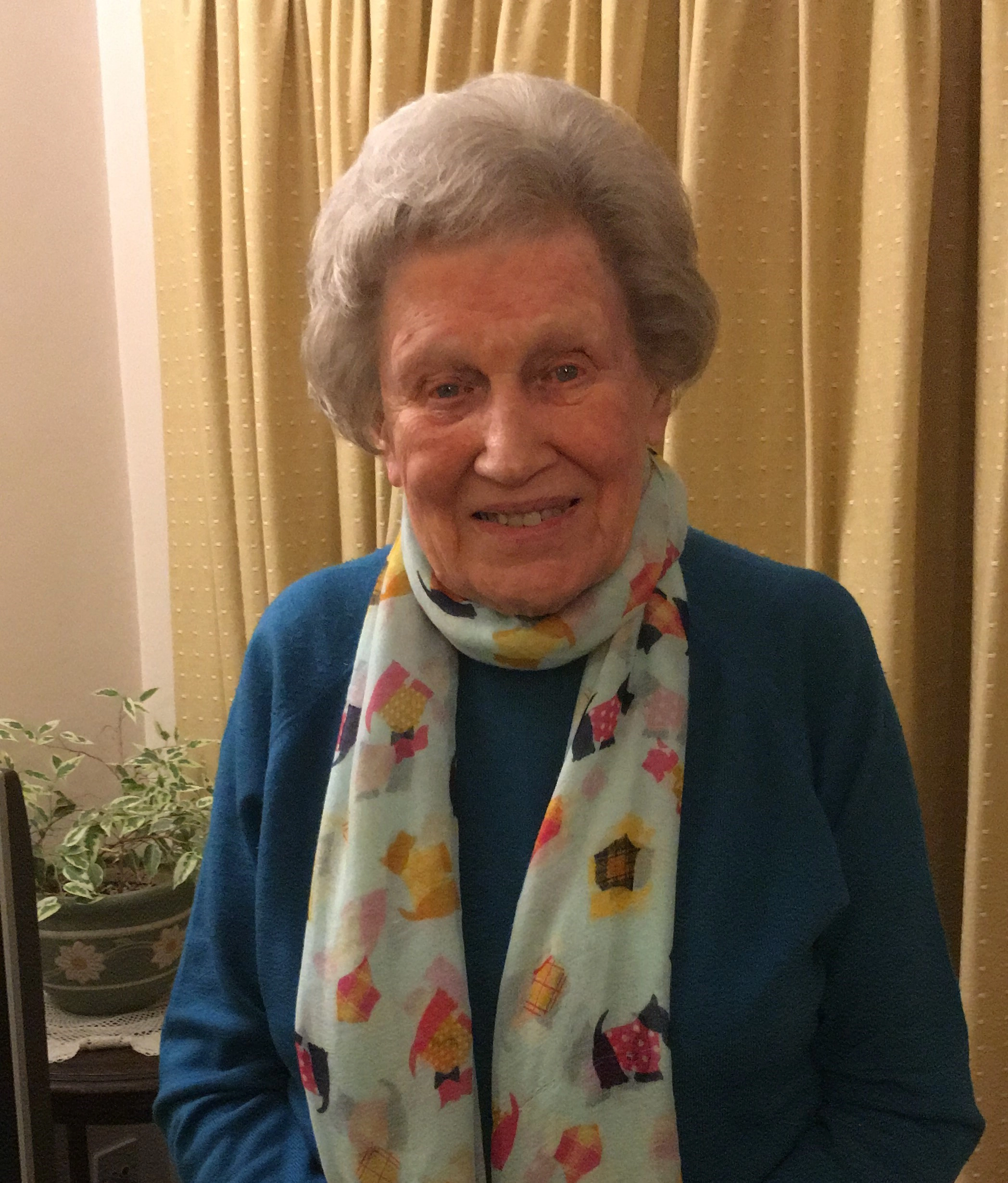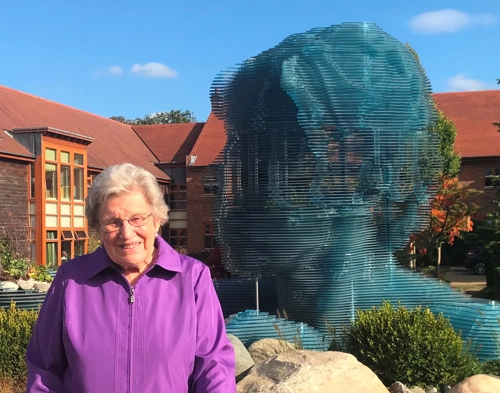
The 85-year-old mother-of-three, grandmother-of-four and great grandmother-of-two was our first paid Volunteer Coordinator. She organised our Three Bells (bereavement support) Club in the mid-80’s, was Chairman of our Board for seven years, overseeing the move to new premises, and has played an integral role in creating and nurturing our special gardens.
Here she shares some of her recollections…
“I knew about the Hospice from the Snowball Coffee Mornings but my first experience of it was six months after Charles died. My next door neighbour, who was a doctor as well as a Hospice Home Box collector in Abbots Langley, suggested I join its Three Bells bereavement club, run by Dr Hilary Pullon, a GP counsellor nearing retirement who was very keen on psychological support.
They used to meet once a month, in a pub in those days, just outside Hemel Hempstead, and I made some very good friends. When we got too big to go to the pub, we moved to St Peter’s Church thanks to Vera Pullen, who was Church Secretary and it was Vera who recruited me to the role of Voluntary Services Coordinator because of my ability to organise rotas when I was in the Red Cross.
For a very short time I’d been a medical social worker for Hillingdon Borough Council, but I wasn’t ready to retire. With my three children grown up and at university, I was looking for a challenge and something to get my teeth into.
You wouldn’t believe how primitive it all was at the beginning. Other hospices were starting up and we were all helping each other but I believed in the Hospice movement.
I was the only employed staff member apart from the medical director, the matron and the nurses – the only lay person and that was because the Hospice had been given a grant of £2,500 a year for three years for someone in post to recruit volunteers.
I remember the first day I joined – they gave me a folding table and said if you can find somewhere to put it, you’re in!
My job was to recruit and organise volunteers to man the Hospice and help it make the transition solely from fundraising. There were probably about 30 volunteers when I joined and three years later we had about 150.
It was a long old business and we learned by our mistakes really. There were about 10 different groups all working independently. They’d go off duty and the next shift wouldn’t know what had happened, so I hit on the idea of a diary so people could write down what they’d done. So simple, but they loved it!
There was one occasion when a volunteer gave a patient a cup of tea, and no-one had told that volunteer that the patient couldn’t manage tea so it went all over her. This started a system where volunteers would speak to the senior nurses and ask them what patients could and couldn’t have.
It was quite easy to recruit – as Pam Macpherson used to say, everyone has a talent, which gets better for using. I remember recruiting a judge and doctors who just wanted to make a contribution. I was able to recruit quite a number from the Three Bells Club because their hearts were absolutely in it.
When Pam Macpherson left - I was just a few months into my post, she asked me to promise her I’d keep the Three Bells Club going. I kept it going for seven years, alongside my volunteer co-ordinator role. It had become a supper club with quite large numbers, but I was doing most of the cooking so I set up a committee and got everyone to pitch in. Dr Pullon would make a point of sitting next to a new person on their first night, we’d all move around after the main meal and it was a wonderful way for widows and widowers to get away from the subject of bereavement and just be normal.

Gardening had been our main interest when Charles was alive, so after he died, at the suggestion of a great friend of mine, who happened to be the wife of recently retired Abbots Langley GP, Peter Thomson. She suggested that Peter and I started a plant nursery – The Abbots House Garden Nursery, out of a big greenhouse and a double layered poly-tunnel in his garden.
I used to take in flowers for the Hospice and as soon as they found out I had an interest in plants, they asked if I’d take special responsibility for the gardens, and so it became my job to organise the volunteers who until then would turn up ad hoc to mow the lawn.
There wasn’t an awful lot in the quarter-acre gardens at Shrublands Road, but the first thing I did was arrange for the netting around the grass tennis court to be removed.
The Friends Group raised money to put in a path to make access easier, we put in a tarmac driveway for cars to park, and the trustees were persuaded to buy a really lovely summerhouse so we could develop an area outside the Hospice where patients and their visitors could go to be quiet.
I started giving people specific tasks – you couldn’t just have people doing what they wanted. Many of my volunteers were keen gardeners who donated plants and shrubs, and being south-facing, it was quite a good space. We built a rock garden immediately outside the bedroom windows at the back and, a tiny pond with a fountain. We generally got the trees into some sort of shape and we put in new shrubs here and there.
We suddenly realised that the patients who were put in the garden rooms who were near the end of their days lasted much longer than expected. That’s when we really began to appreciate the importance of the gardens in terms of their healing and therapeutic value.
Graham Pocket, a garden designer known to the builders, designed the 7-acre gardens at Spring Garden Lane – predominantly low maintenance multiple planting. We had a plant list and John Savage, a great volunteer gardener to this day who had two allotments, gave us one of them so we could propagate a lot of the plants. We propagated everything we could especially very expensive plants – with a lot of help from Peter Thompson and his poly-tunnel.
Once we secured outline planning permission to build a new hospice there in 2002, our first job way before building work started, was to establish and secure the boundary – in between the rusty cars! We had no facilities. We used to go up there, I’d blow my whistle at 11am and everyone would emerge from the bushes. We’d have coffee and a little nip of whisky when it was really cold. We had so much fun. It’s a wonderful story.
Knowing the Shrublands Road site was going to be demolished, we brought as much compost and as many plants and shrubs with us as we could. Bill Frew, a neighbour from Shrublands Road and subsequent trustee, had a son who ran a nursery in Scotland. The son scouted round for unusual plants, which he got at rock bottom prices for us, and would send them down on great big lorries. Everyone worked so hard.
My whole time as Chairman of the Board was preoccupied with finding a new site – we considered 21 in all – and securing planning permission to build a new Hospice. It was monumental – a huge learning curve for me, but a journey of discovery.
There was laughter, tears and lots of sleepless nights. You can’t be at the top of anything without being a bit lonely and Hilary Pullon from the Three Bells Club was my mentor. I didn’t have a husband or anyone else I could trust enough to confide in. Hilary was wonderful. I never pretended to be a professional. I just said I’m a housewife and I’ve been asked to do this job – it went down well with some and not with others.
When I stood down from the Board in 2004, I was afraid that the minute I left, everyone would start pulling things out of the garden and putting other things in. The idea was that it would be low maintenance and the moment you start taking out shrubs and evergreens, you are adding to the stress.
But I needn’t have worried. John Savage, then Jackie Anwyl succeeded me, and I knew everything was in safe hands. John loved his plants and lawn and Jackie was very artistic and had a great ability to get on with people and to listen. As a result, the gardens, now in Ray’s hands, have gone from strength to strength.
Two of my fondest memories are when a group of 20 or so of us, including two parish priests, beat the bounds when outline planning permission was granted. It’s an ancient custom to share the knowledge of where we lay and to pray for protection and blessings for the land.
It wasn’t raining but as we looked up to the sky, a double rainbow appeared. It took us back to Genesis – ‘If you see a bow in the sky there shall I be.’ We felt truly treasured.
The other was the topping out ceremony when the last tile was put on the roof of the new Hospice at the end of 2006. It meant we’d achieved our objective of the new Hospice being built and I just felt it was a very big achievement….”
BIOGRAPHY
Organiser of the Three Bells Club from June 1986-1991
Regional rep for London and SE on National Ass of Hospice Voluntary Services Coordinators 1988-93.
In attendance at Council meetings from 1989.
Council rep on the “Friends Committee” from 1991-1996
Became member of the Council in July 1992 with special responsibility for the gardens.
Appointed Hospice Voluntary Services Coordinator April-June 1992.
Served on the House Committee
Appointed Chairman of Council in Oct 1997-July 2004.
Served on the Strategy Committee; Development (now Project) Committee; I n attendance at Finance and Fundraising Committee.







Share Article